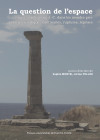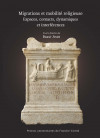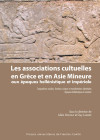
- Summary
-
Inscribed in dynamic systems, places of worship are defined as spaces of tension and appropriation, where rites take on meaning with the practice of cultores whose possible membership in different communities prompts us to question how each from them appropriates this religious landscape. The work aims to reveal the relational logics at work around places of worship by examining archaeological and religious remains, religious inscriptions and literary sources in order to observe the continuity, adaptation or, in the long time, the conversion of these spaces, private or public, in Rome or in the provinces.
- Contents
-
Introduction
Le Canopisme commence à Eleusis (Strabon, XVII, 1, 16). Quelques réflexions sur un territoire sacré à scandale
Jean-Yves Carrez
« Honore le dieu et oublie les hommes ! » Pausanias et la difficile cohabitation entre hommes et divinités
Jean-Christophe Vincent
La pratique religieuse de l’esclave et du maître dans la domus : phénomènes de cohabitation dissymétrique
Bassir Amiri
La zone sacrée du Timave : carrefour culturel et cultuel dans l’arc nord-adriatique
Federica Fontana
Cohabitations religieuses dans le district aurifère d’Alburnus Maior en Dacie
Françoise Van Haeperen, Federica Gatto
Civils et militaires dans le paysage religieux de Mayence sous le Haut Empire
Marie-Thérèse Raepsaet-Charlier
Cohabitations de dédicaces dans l’Asclépiéion de Pergame. Divinités – Textes – Supports
Lavinia Ferretti
Condividere il sacro. Collettività, contaminazioni e identità sociali nei santuari del mondo latino
Clara di Fazio
Les classes populaires de Rome et l’intégration par les cultes : le cas de Silvanus
Nicolas Tran
Conclusion
- Author (s)
-
Bassir AMIRI (edit. director)Bassir Amiri is Senior Lecturer in Roman History at the University of Bourgogne-Franche-Comté. His work focuses on social history and Roman religion.
- Readership
-
The book is mainly aimed at the scientific community (researchers and teacher-researchers in ancient history, epigraphy, ancient religions), students and an audience interested in religious questions relating to antiquity.
- downloadable items
- Reviews and press reviews
- Support (s)
-
Publié avec le concours de l’Institut des Sciences et Techniques de l’Antiquité (UFC) et de la Région de Franche-Comté












